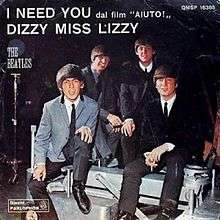I Need You (Beatles song)
| "I Need You" | |
|---|---|
 The Italian single release of the song, backed with "Dizzy Miss Lizzy" | |
| Song by the Beatles | |
| from the album Help! | |
| Published | Northern Songs |
| Released | 6 August 1965 |
| Recorded |
15–16 February 1965, EMI Studios, London |
| Genre | Pop rock[1] |
| Length | 2:28 |
| Label | Parlophone |
| Songwriter(s) | George Harrison |
| Producer(s) | George Martin |
"I Need You" is a song by the Beatles and appears on the album Help!. It is the second George Harrison song the band released[2] after two albums without any songwriting contribution from Harrison. It was performed in their second film, Help! and is the second video produced showing George Harrison singing lead vocal (after "I'm Happy Just to Dance with You" from A Hard Day's Night).
Composition
The song was recorded on 15 and 16 February 1965.[3] This was the first recording session for the group in 1965 and included two others, "Ticket to Ride" and "Another Girl", both of which were also included on the Help! album. The song is often assumed to be addressing Harrison's relationship with Pattie Boyd, whom he had met in March 1964 while filming A Hard Day's Night[2] (they married in January 1966).[4]
Some Beatles' books have claimed that George wrote it in the Bahamas while separated from Pattie, but this can't be true as recording began on February 15th, 1965, and the Bahamas scenes weren't shot until the following week.[5]
Musical characteristics and recording
The song is in A major (actually a little less than half a semitone below A, as were "Ticket to Ride" and "Another Girl", also recorded that day). The recording's distinctive lead guitar cadences were achieved through Harrison's first recorded use of a volume pedal[2][3] (used again on the Lennon composition "Yes It Is" from the same sessions), and by common guitar suspended chords in the key of A. These form the introduction and most of the verse of the song and give a quasi-modal effect relieved in the verse by a line in the relative minor (with a simple backing harmony from Lennon and McCartney), the whole making a fourteen-bar ternary verse-structure. This, after a repeat, segues easily into a second, bridge melody that introduces a cowbell for contrast and is based on a simple IV-V-I chord progression that passes through the dominant key to resolve back on the verse.[1]
An interesting feature is the use of an imperfect cadence (resolving on A Major) in the climax of the bridge (on "I just can't go on anymore") which uses II (B7) and V (E7) chords.[6] Many such aspects of the song are developed in Harrison's song "If I Needed Someone" on the group's next album, Rubber Soul.
Personnel
George Martin kept notes during the session that documented the unusual arrangement, which was:
- George Harrison – double-tracked vocal, acoustic rhythm guitar, twelve-string lead guitar
- John Lennon – harmony vocal, snare drum
- Paul McCartney – harmony vocal, bass
- Ringo Starr – acoustic guitar percussion, cowbell
- Personnel per George Martin, quoted in Ryan and Kehew [7]
Cover versions
- The Sunshine Company recorded a version, arranged by George Tipton, for their 1967 Imperial Records LP Happy Is the Sunshine Company.[8]
- Tom Petty and the Heartbreakers played the song in tribute to Harrison at the Concert for George in 2002.[9]
- The progressive rock supergroup Transatlantic recorded a mix of two songs called "I Need You" (this one and America's 1972 single) on their 2009 album The Whirlwind. The first part (America's cover) is sung by Neal Morse while the Beatles's part features vocals by the band's drummer Mike Portnoy.
- The Lolas have done a cover version
- Steve Perry recorded a re-imagined version for his 2018 album, Traces.
Notes
- 1 2 Pollack 1992.
- 1 2 3 MacDonald 2005, pp. 145–146.
- 1 2 Lewisohn 1988, p. 54.
- ↑ Harry 2000, p. 199.
- ↑ Steve Turner & "The Beatles A Hard Days Write" (The Stories Behind Every Song), p. 119.
- ↑ Dominic Pedler. Songwriting Secrets of the Beatles. Omnibus Press, London 2003 p 95.
- ↑ Ryan & Kehew 2006, p. 389.
- ↑
- ↑ "Concert for George". allmusic.com. Retrieved 3 January 2015.
References
- Concert for George (booklet). London: Oops Publishing. 2002. R2 745/16.
- Harry, Bill (2000). The Beatles Encyclopedia: Revised and Updated. London: Virgin Publishing. ISBN 0-7535-0481-2.
- Lewisohn, Mark (1988). The Beatles Recording Sessions. New York: Harmony Books. ISBN 0-517-57066-1.
- MacDonald, Ian (2005). Revolution in the Head: The Beatles' Records and the Sixties (Second Revised ed.). London: Pimlico (Rand). ISBN 1-84413-828-3.
- Pollack, Alan (7 December 1992). "Notes on "I Need You"". Notes on ... Series.
- Ryan, Kevin; Kehew, Brian (2006). Recording the Beatles: The Studio Equipment and Techniques Used to Create Their Classic Albums. n.p.: Curvebender Publishing. ISBN 0-9785200-0-9.